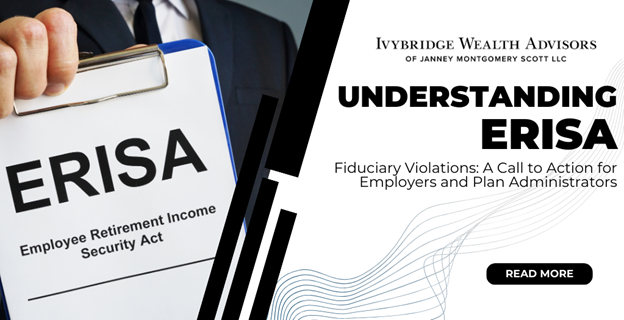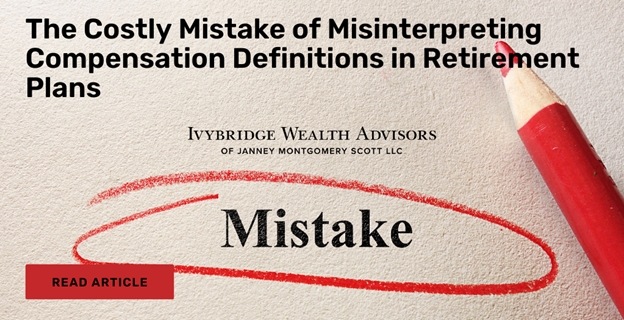
Attention HR and Finance Professionals and Business Leaders
Recent events have put a spotlight on the critical topic of fiduciary responsibilities and the repercussions of violations within retirement plans. As stewards of these plans, understanding our obligations and the potential penalties for non-compliance is more crucial than ever.A fiduciary is anyone who exercises discretionary authority or control over a retirement plan's management or its assets, including anyone who provides investment advice to the plan. Failing to adhere to the principles of prudence, diversification, adherence to the plan documents, and acting in the best interest of the participants can lead to significant consequences.Violations can result in:Civil Penalties: The Department of Labor (DOL) can enforce actions to correct violations, including the restoration of losses to the plan and the implementation of necessary measures to prevent future breaches.Excise Taxes and Penalties: The IRS can impose excise taxes on prohibited transactions and other breaches of fiduciary duty.Personal Liability: Perhaps most daunting is the personal liability fiduciaries may face for breaches of their responsibilities, including reimbursing the plan for losses incurred due to the breach.These penalties underscore the importance of diligent plan management and the need for continuous education on the evolving landscape of fiduciary duty.Let’s use this as a reminder to review our practices, ensure compliance with ERISA standards, and seek expert advice when necessary. The responsibility is great, but so is the opportunity to positively impact the financial well-being of our employees.#RetirementPlanning #Compliance #HR #BusinessLeadershipThe concepts illustrated here have legal, accounting and tax implications. Neither Janney Montgomery Scott LLC nor its Financial Advisors give tax, legal, or accounting advice. Please consult with the appropriate professional for advice concerning your individual circumstances. For more information about Janney, please see Janney's Relationship Summary (Form CRS) on www.janney.com/crs which details all material facts about the scope and terms of our relationship with you and any potential conflicts of interest.

Elevating Retirement Plan Participation: Strategies for Success
In the realm of benefits administration, fostering high participation in retirement plans is not just a goal—it's a mission. As Plan Administrators, you hold the key to unlocking the full potential of your workforce's future financial stability. The challenge? Engaging every eligible employee and guiding them toward a secure retirement.Here’s how you can make a tangible impact: Effective CommunicationPersonalized Outreach: Craft messages that speak directly to the unique needs and aspirations of different employee demographics. Understand that a one-size-fits-all approach doesn't work for everyone.Diverse Channels: Utilize a mix of emails, intranet announcements, informational webinars, and face-to-face meetings to reach employees where they are most comfortable. Empower Through EducationFinancial Wellness Workshops: Offer sessions that cover the basics of retirement savings, investment principles, and the benefits of early enrollment.Easy-to-Understand Resources: Break down complex retirement plan details into digestible, engaging content formats like videos, infographics, and quick-read guides. Data-Driven StrategyGather Insights: Use surveys and feedback tools to understand common barriers to participation. What misconceptions or obstacles are keeping employees from enrolling?Tailor Plans: Analyze workforce data to customize retirement plan options that align with the diverse needs of your employees. Simplify the Enrollment ProcessStreamlined Sign-Up: Ensure the enrollment process is as easy as possible. Consider online platforms that offer a seamless signup experience.One-on-One Support: Provide personalized guidance for employees who need assistance understanding their options or the enrollment process. Highlight Benefits and IncentivesShowcase the Value: Regularly communicate the tangible benefits of participating in the retirement plan, including employer match contributions, tax advantages, and compound interest.Success Stories: Share real-life examples of how participating in the retirement plan has positively impacted employees within your organization. Encourage Early and Consistent ParticipationStart Early: Emphasize the importance of starting retirement savings as early as possible to maximize the benefits of compounding.Consistency is Key: Encourage employees to contribute consistently, even if it's a small amount, to build a substantial retirement fund over time. Leadership AdvocacyEngagement from the Top: Have organizational leaders actively promote and participate in the retirement plan, sharing their personal experiences and the value they’ve found in participating.Visibility Matters: Leverage leadership influence in company-wide meetings, newsletters, and other communications to underscore the importance of retirement planning. As Plan Administrators, you have a pivotal role in shaping the future financial well-being of your employees. By deploying targeted strategies, simplifying the complex, and championing the cause at every level, you can drive meaningful participation in your retirement plans. Work to ensure every eligible employee is on the path to a secure, prosperous retirement.You can build a future where every employee has the opportunity to retire with dignity and security.#RetirementPlanning #FinancialWellbeing #EmployeeEngagement #HRLeadership

Navigating Success: The Power of Setting Proper Financial Goals for Small Businesses
As a small business owner, you're no stranger to the myriad challenges that come with entrepreneurship. From managing finances to driving growth, every decision you make plays a pivotal role in shaping the trajectory of your business.In this article, we'll delve into the importance of setting proper financial goals and how doing so can pave the way for success. Understanding the Significance of Financial GoalsStrategic Alignment: Proper financial goals serve as a compass, guiding your business in the right direction. By aligning your financial objectives with your broader strategic vision, you create a roadmap for success that ensures every decision contributes to your overarching goals.Resource Optimization: Setting smart financial goals enables you to optimize resources efficiently. Whether it's allocating budgets, prioritizing investments, or streamlining expenses, a clear understanding of your financial objectives empowers you to make informed decisions that maximize returns and minimize risks.Performance Measurement: Adequate financial goals provide measurable benchmarks for assessing your business's performance. By defining specific targets, you create accountability within your organization and establish metrics to track progress, identify areas for improvement, and celebrate achievements along the way. The Components of Smart Financial Goals#1 SpecificityEffective financial goals are specific and clearly defined. Avoid vague aspirations and instead, articulate precise targets that address key areas of your business, such as revenue growth, profitability, cost reduction, or market expansion.#2 MeasurabilityTangible metrics are essential for gauging progress and success. Ensure your financial goals are measurable, whether in terms of revenue figures, profit margins, market share, customer acquisition rates, or other relevant KPIs that align with your business objectives.#3 AchievabilityWhile it's important to aim high, setting realistic goals is equally crucial. Consider your business's current capabilities, market conditions, and industry benchmarks when establishing financial targets to ensure they are attainable within a reasonable timeframe.#4 RelevanceYour financial goals should align with your broader business strategy and priorities. Ensure they address key areas of concern or opportunity within your organization and contribute to the overarching vision and mission of your business.#5 Time-BoundSetting deadlines or time frames for achieving your financial goals adds a sense of urgency and accountability. Establish clear timelines or milestones to track progress and keep your team focused on meeting objectives within specified deadlines. Tips for Setting Adequate Financial GoalsConduct a Financial Assessment: Start by evaluating your business's current financial health. Review income statements, balance sheets, cash flow statements, and other financial records to identify strengths, weaknesses, opportunities, and threats.Identify Key Priorities: Determine the most critical areas where financial improvement or investment is needed. Whether it's expanding into new markets, launching new products or services, or improving operational efficiency, prioritize goals that align with your business's strategic objectives.Involve Your Team: Collaborate with key stakeholders, including managers, employees, and financial advisors, when setting financial goals. Encourage open dialogue and brainstorming sessions to gain diverse perspectives and insights that can inform goal-setting decisions.Monitor and Adjust: Establish a system for monitoring progress towards your financial goals and regularly review performance metrics. Be prepared to adapt and adjust goals as needed based on changing market conditions, emerging opportunities, or unforeseen challenges.Celebrate Achievements: Recognize and celebrate milestones and achievements along the way to keep morale high and motivation levels up. Whether it's reaching a revenue milestone, achieving a target profit margin, or surpassing sales projections, acknowledging successes reinforces the importance of goal-setting and encourages continued effort. In conclusion, setting proper financial goals is not just a strategic exercise; it's a cornerstone of small business success. By defining clear objectives, adhering to smart criteria, and leveraging actionable tips, you empower your business to thrive and prosper amidst uncertainty and competition. Embrace the power of financial goal-setting as a catalyst for growth, and watch as your business charts a course towards sustainable success and prosperity.

The Power of Setting Financial Goals: A Blueprint for Small Business Success
As a small business owner, navigating the complex terrain of entrepreneurship can sometimes feel like setting sail on uncharted waters. From managing day-to-day operations to keeping an eye on long-term growth, the responsibilities can seem overwhelming. However, amidst the hustle and bustle of business ownership, there lies a crucial compass that can guide you through turbulent times and steer your enterprise towards success: financial goals.In today's dynamic business landscape, having a clear vision of your financial objectives is paramount. It's not just about making money; it's about strategically allocating resources, planning for contingencies, and ultimately, laying the groundwork for sustainable growth.Here, we'll delve into why setting financial goals is essential for small business success and provide actionable tips to help you chart a course towards financial prosperity. Why Financial Goals MatterStrategic Direction: Financial goals serve as a roadmap, providing clarity and direction for your business endeavors. Whether it's increasing revenue, expanding your customer base, or reducing overhead costs, setting concrete financial objectives empowers you to make informed decisions that align with your overarching vision.Motivation and Focus: Setting financial goals instills a sense of purpose and motivation within your team. By establishing measurable targets, you create a shared vision that inspires collective effort and fosters a culture of accountability and achievement.Risk Mitigation: In an unpredictable business environment, having predefined financial goals acts as a safeguard against unforeseen challenges. By anticipating potential risks and planning accordingly, you mitigate vulnerabilities and position your business for resilience in the face of adversity. Setting Adequate and Realistic Financial Goals#1 Evaluate Your Current Financial PositionBefore charting a course towards your financial objectives, take stock of your current financial standing. Conduct a thorough assessment of your revenue streams, expenses, cash flow patterns, and existing assets and liabilities. This baseline evaluation will provide valuable insights into where your business stands and serve as a foundation for setting realistic goals.#2 Define Clear and Measurable ObjectivesWhen setting financial goals, specificity is key. Avoid vague aspirations and instead, articulate precise targets that are quantifiable and time-bound. Whether it's achieving a certain revenue milestone, reducing operational costs by a specific percentage, or increasing profit margins, clarity ensures accountability and facilitates progress tracking.#3 Consider Short-term and Long-term GoalsStrike a balance between short-term wins and long-term aspirations. While immediate financial targets offer quick wins and momentum, don't lose sight of your overarching strategic vision. Incorporate both short-term milestones and long-term objectives into your goal-setting framework to foster sustainable growth and continuous improvement.#4 Factor in External VariablesAcknowledge the external factors that may influence your business's financial trajectory. Whether it's market fluctuations, regulatory changes, or competitive pressures, anticipate external variables and incorporate contingency plans into your goal-setting strategy. Flexibility and adaptability are essential traits for navigating uncertain terrain.#5 Seek Professional GuidanceDon't hesitate to enlist the expertise of financial professionals or business advisors. Collaborating with seasoned professionals can provide invaluable insights, identify blind spots, and refine your financial goals to align with industry best practices and market trends.#6 Regularly Monitor and Adjust GoalsSetting financial goals is not a one-time endeavor; it's an ongoing process that requires regular monitoring and adjustment. Establish a system for tracking your progress, analyzing performance metrics, and reassessing goals based on changing circumstances. Embrace a culture of continuous improvement and agility to stay responsive to evolving business dynamics. In conclusion, setting financial goals is not just a strategic exercise; it's a fundamental pillar of small business success. By defining clear objectives, aligning resources, and fostering a culture of accountability, you empower your business to thrive amidst uncertainty and adversity. Embrace the power of financial goal-setting as a catalyst for growth, and chart a course towards a prosperous future for your small business.

Understanding the Consequences of Failing Retirement Plan Testing
Retirement plan compliance testing is a critical aspect of managing a 401(k) or similar employer-sponsored retirement plan. It ensures that the plan operates within the regulatory frameworks set by the IRS and the Department of Labor. Unfortunately, failing these compliance tests can have significant consequences for both employers and employees.Here’s what you need to know:#1 Corrective DistributionsFailing the Actual Deferral Percentage (ADP) or Actual Contribution Percentage (ACP) tests can lead to corrective distributions. This means highly compensated employees (HCEs) might receive a refund of their contributions to the plan, which is then taxed as income. This not only affects the employee's retirement savings but can also lead to dissatisfaction among your key talent.#2 Tax PenaltiesBoth employers and employees can face tax penalties for non-compliance. Employers might be subject to excise taxes for failing to make the necessary corrections within the prescribed timeframe. Additionally, corrective distributions to HCEs can increase their tax liability, affecting their net income and satisfaction with the retirement plan offerings.#3 Plan Disqualification RiskWhile rare, severe non-compliance issues can lead to plan disqualification. This would make all plan assets taxable and remove the tax benefits associated with the retirement plan, significantly impacting all plan participants and the sponsoring employer.#4 Increased Scrutiny and CostsFailing compliance tests can lead to increased scrutiny from regulatory bodies, potentially resulting in more frequent audits and the associated costs. It can also increase the administrative burden on the plan sponsor, requiring more time and resources to manage the plan effectively.#5 Employee Morale and RetentionThe implications of failing retirement plan testing extend beyond financial penalties. They can affect the perception of the company among employees, potentially impacting morale and retention. A retirement plan is a valuable benefit, and its mismanagement can lead to dissatisfaction and turnover.Action Steps:To avoid these consequences, employers should proactively engage with their plan administrators to ensure ongoing compliance, consider plan design changes that reduce the risk of failing tests, and educate their employees about the importance of balanced contributions across all compensation levels.Engaging a knowledgeable retirement plan consultant can also help navigate the complexities of compliance, ensuring your plan remains an asset rather than a liability.Let’s discuss more on how we can ensure our retirement plans are robust, compliant, and beneficial for all.#RetirementPlanning #Compliance #HR #Finance

Understanding ERISA Fiduciary Violations: A Call to Action for Employers and Plan Administrators
In the complex landscape of employee benefits management, the significance of adhering to the Employee Retirement Income Security Act (ERISA) cannot be overstated. At the heart of ERISA are the fiduciary duties that require plan administrators and employers to act in the best interests of plan participants and beneficiaries. Fiduciary violations under ERISA are a serious matter, carrying substantial penalties and underscoring the importance of diligence and compliance in managing retirement plans.What Constitutes a Fiduciary Violation?Fiduciary violations typically involve:Failure to act prudently and solely in the interest of participantsImproper selection and monitoring of plan investmentsAllowing excessive fees or prohibited transactionsThe Penalties: A Costly AffairThe repercussions of fiduciary breaches are significant, including:Personal Liability: Fiduciaries can be held personally liable to restore any losses to the plan or to restore any profits made through improper use of plan assets.Penalties and Excise Taxes: The Department of Labor (DOL) can assess civil penalties, and the IRS may impose excise taxes on prohibited transactions.Legal Expenses: The cost of defending against litigation can be substantial, not to mention the potential for settlements or judgments.Mitigating Risks and Ensuring ComplianceTo safeguard against fiduciary violations, it is essential to:#1 Educate Yourself and Your Team: Understand the extent of your fiduciary responsibilities under ERISA.#2 Implement Strong Governance Practices: Regularly review plan investments, monitor service providers, and document decision-making processes.#3 Seek Expert Guidance: Consider consulting with ERISA specialists or legal counsel to ensure your plans comply with all aspects of ERISA.The responsibility of managing employee benefits plans is immense, with fiduciary duties at its core. As stewards of these plans, it is our duty to ensure compliance not just to avoid penalties but to protect the interests of the very people who depend on these benefits for their future.Let's commit to best practices in benefits plan management and uphold the highest standards of fiduciary responsibility. Together, we can navigate the complexities of ERISA compliance and foster a culture of trust and integrity in our organizations.#ERISA #Compliance #EmployeeBenefits #HRLeadership

The High Cost of Ignoring Hardship Distribution Compliance
Retirement plans often include provisions for hardship distributions, allowing participants to make early withdrawals under specific circumstances. However, straying from the stringent rules governing these distributions can lead to a cascade of problems.Let's examine the potential impact of non-compliance:#1 Tax Consequences for Employees: When hardship distributions don’t meet regulatory requirements, the amount withdrawn can be subject to taxes and, if the employee is under 59½, an additional 10% early withdrawal penalty. This can substantially reduce the intended financial relief.#2 Plan Disqualification Risk: Severe non-compliance could jeopardize the plan's qualified status. If disqualified, all plan assets may become taxable to the participants, eroding the tax-deferred growth and benefits that make 401(k) plans advantageous.#3 Operational Challenges: Correcting non-compliance post-distribution is operationally burdensome. It may involve complex corrective measures like self-correction programs or voluntary correction programs with the IRS, which can be costly and time-consuming.#4 Fiduciary Liability: Plan sponsors have a fiduciary duty to operate in the best interest of participants. Non-compliance could lead to breaches of fiduciary duties, resulting in legal challenges, financial penalties, and reputational damage.#5 Employee Relations and Morale: Mismanagement of hardship distributions can cause mistrust and dissatisfaction among employees, which may impact overall morale and potentially lead to turnover.Proactive Measures● Regularly review and update hardship distribution procedures to align with current regulations.● Educate employees about the rules and ramifications of hardship distributions.● Conduct periodic audits of hardship distributions to ensure compliance.● Collaborate with plan providers and legal advisors to manage and mitigate potential risks.In conclusion, the importance of maintaining compliance with hardship distribution rules cannot be overstated. It safeguards not only the fiscal health of the retirement plan but also the financial wellbeing of its participants.Let's connect and explore how rigorous compliance can be seamlessly integrated into our retirement plan management.#RetirementPlanCompliance #HR #Finance #EmployeeBenefits

The Costly Mistake of Misinterpreting Compensation Definitions in Retirement Plans
In the world of retirement plan administration, precision is key – especially when it comes to compensation definitions. Misinterpretation here can have cascading effects, potentially impacting employee savings and even leading to regulatory penalties.Impact on Contributions and BenefitsIncorrectly defining compensation can result in improper contribution calculations. This doesn't just affect matching contributions but can also skew the benefit calculations, leading to lower retirement savings for employees or unexpected costs for employers.Compliance RisksCompensation definition errors may lead to compliance issues with IRS and DOL regulations. This can trigger audits, corrective distributions, and amendments, leading to hefty fines and a loss of qualified status for the plan.Operational ChallengesAn error in one area can create a domino effect, causing issues in payroll processing, benefits administration, and even in the reporting and disclosure of plan information.Prevention Strategies:#1 Thorough Plan Document Review: Ensure that your plan documents clearly define compensation for all purposes, including deferrals and matching contributions.#2 Regular Training: Keep your HR and payroll teams informed about the specifics of your plan's compensation definitions.#3 Consistent Audits: Conduct regular internal or external audits to ensure ongoing compliance with the plan's terms.#4 Clear Communication: Maintain transparent communication with employees about how their compensation impacts their retirement savings.In summary, a keen eye for detail and a commitment to understanding the nuances of your plan’s compensation definitions can safeguard against costly errors and secure the financial future of your employees.#RetirementPlans #CompensationManagement #HRCompliance #FinancialWellness

Steering Clear of Plan Disqualification & Prohibited Transactions in Retirement Plans
In the landscape of retirement planning, two critical dangers loom: plan disqualification and prohibited transactions. Understanding these risks is paramount for every plan sponsor, as the consequences can be severe.Plan DisqualificationA retirement plan's qualified status is its lifeline, providing tax benefits to both employers and employees. Should a plan fall out of compliance with IRS or ERISA guidelines, the fallout is substantial:Tax Benefits Forfeited: Contributions could become immediately taxable, impacting both employers and employees.Loss of Tax-Deferred Growth: The power of compounding is compromised, affecting participants' retirement savings.Corrective Measures & Costs: Reinstating qualified status may require extensive corrections and negotiations with regulatory bodies, incurring significant costs.Prohibited TransactionsThese are certain types of transactions between the plan and a disqualified person (e.g., an employer, service provider, or certain employees). They can trigger dire repercussions:Excise Taxes: Initial taxes on prohibited transactions can be 15% of the amount involved, with continuing violations increasing the tax.Personal Liability: Those involved in prohibited transactions can be held personally liable to restore any losses to the plan.Operational and Reputational Damage: The discovery of prohibited transactions can damage the trust in plan management and affect the company's reputation as a responsible employer.Prevention Is KeyRobust Internal Controls: Establish and maintain strong internal controls to prevent and detect non-compliance.Education & Training: Regularly educate staff and participants about the rules and regulations to prevent inadvertent violations.Expert Guidance: Engage with experienced ERISA attorneys and consultants to review plan operations and ensure compliance.In conclusion, the integrity of a retirement plan hinges on adherence to complex regulations. Proactive compliance strategies are not just a legal buffer but a commitment to the financial security of your workforce.Let's connect and share best practices that can help safeguard our retirement plans from disqualification and prohibited transactions.#ERISA #RetirementPlanning #Compliance #HR

Navigating the Complex World of Retirement Plan Management: A Guide for Fiduciaries
In the realm of retirement plan management, the role of a fiduciary is both a privilege and a profound responsibility. Recent developments have cast a spotlight on fiduciary duties and the severe consequences of failing to meet these obligations. Understanding the potential penalties and implementing strategies to prevent violations is crucial for anyone involved in the oversight of retirement plans.Potential Penalties for Fiduciary ViolationsViolating fiduciary duties can lead to serious repercussions, including:#1 Civil Lawsuits: Participants and beneficiaries may file claims for breaches that result in plan losses or by fiduciaries who fail to act in the plan's best interest.#2 Department of Labor (DOL) Enforcement: The DOL can impose penalties, including the requirement to restore losses to the plan and corrective measures to prevent future violations.#3 Personal Liability: Fiduciaries can be personally liable to restore any losses to the plan or to return any improper gains made through the use of plan assets.Preventing Fiduciary ViolationsEnsuring compliance and protecting the interests of plan participants requires a proactive and informed approach. Here are key strategies to prevent fiduciary violations:#1 Education and Training: Regular training for all fiduciaries on their responsibilities and the latest regulations is essential.#2 Adherence to the Plan Document: Follow the plan documents to the letter, as these are the foundation of fiduciary compliance.#3 Prudent Investment Practices: Implement and follow an investment policy statement, conduct regular reviews of investment performance, and ensure diversification to minimize the risk of large losses.#4 Regular Audits and Reviews: Conduct periodic audits of the plan's operations and investments to ensure compliance with ERISA and other relevant laws.#5 Seek Professional Advice: When in doubt, consult with legal and financial advisors who specialize in ERISA and retirement plan management.Final ThoughtsThe landscape of retirement plan management is fraught with challenges, but also filled with opportunities to make a positive impact on the financial well-being of participants. By embracing our fiduciary responsibilities and taking proactive steps to prevent violations, we can safeguard the interests of all stakeholders and ensure the long-term success of the retirement plans we oversee.Let's commit to excellence in fiduciary governance and set a standard for responsible, ethical management of retirement plans.#RetirementPlanning #RiskManagement #Compliance #HRProfessionals

Navigating the Complex Waters of ERISA Compliance: A Must for Employers
As business leaders and HR professionals, it’s crucial to understand the legal and financial stakes involved in managing employee benefits. The Employee Retirement Income Security Act (ERISA) sets strict standards for pension plans in private industry, offering protection for individuals in these plans. However, navigating ERISA’s requirements can be a daunting task, and non-compliance can lead to severe consequences.Legal LiabilitiesFiduciary Breaches: ERISA demands fiduciaries act in the best interest of plan participants. Failure to do so can lead to personal liability, including restitution and penalties.Reporting and Disclosure Failures: Inadequate disclosure of plan information and reporting to government agencies can result in penalties and legal action.Prohibited Transactions: Engaging in transactions considered prohibited under ERISA can invite fines and require parties to undo the transaction at their own expense.Financial LiabilitiesPenalties and Fines: Non-compliance can lead to significant penalties from the Department of Labor (DOL), Internal Revenue Service (IRS), and Pension Benefit Guaranty Corporation (PBGC).Legal Costs: Defending against ERISA litigation can be costly, not just in penalties, but also in legal fees and settlements.Corrective Contributions: Employers may be required to make corrective contributions to make plan participants whole, which can be substantial.Avoiding the Pitfalls#1 Regular Audits: Conduct regular compliance audits of your benefit plans.#2 Educate Your Team: Ensure that anyone involved in managing your benefit plans understands their fiduciary responsibilities.#3 Seek Expert Advice: Consult with legal and financial advisors specializing in ERISA to navigate the complex requirements effectively.Non-compliance with ERISA is not just about facing penalties; it’s about upholding a trust with your employees to manage their benefits with their best interests at heart. Let’s prioritize compliance to foster a trusting and secure work environment.#ERISA #Compliance #EmployeeBenefits #HR #BusinessLeadership

Boosting Retirement Plan Engagement: Key Strategies for Success
In the world of benefits administration, achieving high enrollment in retirement plans is more than a goal—it's a commitment. As Plan Administrators, you're at the forefront of paving the way for your employees' financial security in their golden years. The real challenge lies in captivating every eligible employee and steering them towards a financially secure retirement.Here’s your blueprint for making a significant difference:Tailored CommunicationCustomized Messaging: Develop communications that resonate with the varied needs and dreams of our diverse employee base, moving beyond the generic approach.Varied Channels: Employ a blend of communication methods such as emails, intranet updates, educational webinars, and direct conversations to engage employees in their preferred environments.Education & EmpowermentFinancial Literacy Workshops: Host informative sessions that demystify the principles of retirement saving, investment strategies, and the advantages of joining early.Accessible Resources: Simplify the complexities of retirement plans into easy-to-grasp, compelling materials like video explainers, infographics, and brief guides.Insightful StrategyInsight Collection: Leverage surveys and feedback mechanisms to identify the hurdles to participation. What are the misconceptions or challenges deterring employees?Customized Offerings: Use analytics to adapt retirement plan options to meet the varied preferences of our workforce.Streamlining EnrollmentEffortless Sign-Up: Aim for a frictionless enrollment journey. Opt for online platforms that ensure a smooth and straightforward signing up process.Personalized Assistance: Offer dedicated support to employees who seek help in navigating their choices or the enrollment process.Showcasing Value & IncentivesValue Communication: Consistently underline the real-world benefits of enrolling in the retirement plan, such as employer matching, tax benefits, and the power of compound growth.Impact Stories: Celebrate and share the success stories of employees who have seen significant benefits from participating in the plan.Promoting Early & Steady ContributionsEarly Starts: Stress the importance of initiating retirement contributions early to leverage the magic of compounding to its fullest.Regular Contributions: Motivate employees to make regular contributions, however modest, to cumulatively build a robust retirement fund.Leadership EndorsementTop-Down Engagement: Encourage top executives to lead by example, sharing their positive experiences with the retirement plan.Amplify Visibility: Use the influence of leadership to emphasize the significance of retirement planning in all forms of company communication.In your role as Plan Administrators, you're instrumental in sculpting your employees' financial future. Through focused efforts, demystifying the process, and advocating at every turn, you're set to enhance participation in our retirement plans significantly. It's our collective mission to guide every eligible employee towards a secure and fulfilling retirement.Craft a future where retirement with dignity and security is a reality for every employee.#RetirementPlanning #FinancialSecurity #EmployeeEngagement #HRLeadership

Best Practices for Retirement Plan Administrators: Ensuring Compliance with Plan Documents
Your role as plan administrator extends beyond managing assets; it's about ensuring every aspect of the retirement plan is in strict accordance with governing documents. Compliance is not just a regulatory requirement; it's a cornerstone of plan integrity.Here's how you can stay on course:#1 Thorough Knowledge of Plan DocumentsIt's imperative to fully understand the provisions of your plan document. Regular reviews help ensure that operations match the terms and amendments are well-integrated.#2 Consistent Plan OperationEnsure that the plan operates exactly as written. Any deviation, even well-intentioned, can lead to compliance issues and potentially affect the plan's qualified status.#3 Regular Training for StaffKeep your team informed. Regular training sessions on updates and changes to the plan documents can prevent oversights and maintain a culture of compliance.#4 Internal AuditsConducting internal audits helps identify and correct operational discrepancies before they escalate into compliance issues.#5 Prompt AmendmentsWhen laws change, promptly update your plan documents to reflect the new regulations. This proactive approach can save a lot of trouble down the road.#6 Document Decision-Making ProcessesMaintain a record of all decisions and the reasons behind them. This documentation can be invaluable if you ever need to demonstrate your compliance efforts to regulators or auditors.#7 Engage with ExpertsRegular consultations with ERISA attorneys, compliance specialists, and financial advisors can provide valuable insights and help navigate the complexities of retirement plan management.By embedding these practices into your operations, you not only uphold the law but also build trust with your participants, ensuring that their retirement funds are managed with the utmost integrity.Are you ready to elevate your compliance strategy? Let's connect and share insights that promote excellence in retirement plan administration.#RetirementPlans #Compliance #PlanAdministration #ERISA

The Hidden Costs of Recordkeeping Errors: Employee Exclusion from Retirement Plans
In the complex world of retirement plan administration, the accuracy of recordkeeping cannot be overstated. Yet, errors do occur, and when they lead to the exclusion of eligible employees from participating in a retirement plan, the consequences can ripple through an organization, affecting morale, compliance, and the financial well-being of both employees and the company.Here’s a deeper dive:#1 Impact on Employee Financial Security: Excluding eligible employees from a retirement plan, even inadvertently, can significantly impact their long-term financial security. It denies them the opportunity to save for retirement with pre-tax dollars and potentially miss out on employer matching contributions, compounding over time to a substantial loss.#2 Compliance Violations and Penalties: Such errors can lead to non-compliance with ERISA and IRS regulations, exposing the organization to penalties, corrective measures, and the risk of litigation. The administrative burden of correcting these errors can be significant, not to mention the potential financial penalties.#3 Employee Trust and Morale: Discovering that one has been wrongly excluded from a retirement plan can erode trust in the employer and negatively impact employee morale. It sends a message of oversight and mismanagement, potentially affecting employee engagement and productivity.#4 Reputational Damage: Beyond the immediate circle of affected employees, significant recordkeeping errors can tarnish an organization’s reputation as a good place to work, impacting talent acquisition and retention. In today’s social media age, such news can spread quickly, affecting the company’s public image and employer brand.#5 Legal and Financial Ramifications: Correcting exclusion errors often requires retroactive contributions and potentially compensating for lost earnings, which can be financially taxing. Additionally, if these errors lead to litigation, the costs can escalate quickly, including legal fees and settlements.Preventative Measures:● Implement robust recordkeeping and audit systems to catch and correct errors promptly.● Regularly train HR and finance teams on the latest retirement plan compliance requirements.● Engage with a third-party administrator (TPA) or consultant to review plan operations and compliance.Conclusion: The integrity of recordkeeping practices is foundational to the successful administration of retirement plans. Investing in preventative measures and fostering a culture of compliance and diligence is not just about avoiding penalties; it's about securing the trust and financial future of your employees.Let’s engage in a constructive dialogue on best practices for mitigating such risks and ensuring our employees are supported in their retirement planning.#HR #RetirementPlanning #Compliance #EmployeeBenefits

Taxable Distributions: The Cost of Non-Compliant Retirement Plan Loans
Retirement plans often offer loan provisions as a benefit to participants, providing a source of funds without an actual distribution. However, when these loans fail to comply with IRS regulations, they can become taxable events.Let’s unpack the repercussions:#1 Immediate Taxation: If a loan from a retirement plan doesn’t meet the IRS requirements or isn’t repaid according to the terms, it may be considered a distribution and thus become subject to income tax.#2 Penalty for Early Withdrawal: Participants under the age of 59½ may face a 10% early withdrawal penalty in addition to income taxes on the defaulted loan amount, significantly increasing the cost of the loan.#3 Impact on Retirement Savings: The defaulted loan amount, now taxed, erodes the retirement savings meant to compound over time, reducing the total retirement assets available to the participant.#4 Plan Integrity and Fiduciary Risk: Frequent loan defaults could call into question the integrity of the retirement plan and potentially expose plan fiduciaries to scrutiny for failing to administer the plan prudently.#5 Administrative Complications: The process of treating non-compliant loans as distributions involves complex administrative steps, including issuing corrected Forms 1099-R to the affected participants and possibly amending prior plan filings.Preventive Strategies:● Clearly communicate loan terms and conditions to all participants.● Ensure rigorous adherence to the plan document and IRS regulations.● Monitor loan repayments diligently and send timely reminders to participants.● Consider limiting the number and amount of loans available to reduce risk.Non-compliant loans can turn a well-intended provision into a financial setback for employees. It's essential to balance the flexibility of retirement plan loans with the responsibility to maintain compliance and protect the retirement readiness of all participants.Engage with experts and plan administrators to fortify your loan provisions against compliance breaches. Share your thoughts on how we can enhance the effectiveness of retirement plan loans responsibly.#RetirementPlanning #TaxCompliance #FinancialWellness #EmployeeBenefits

Maximizing Employee Benefits: The Importance of a Well-Designed 401(k) Plan
Employees today consider 401(k) plans as one of the most appreciated work-related benefits. A robust 401(k) plan not only benefits your workforce but also plays a pivotal role in attracting top talent and keeping your business competitive in the industry. While the allure of a well-structured 401(k) is evident, it's important to recognize that operating such a plan can be complex, demanding, and time-consuming.Let's delve into the key elements involved in managing a 401(k) plan effectively.The Many Facets of 401(k) Plan Management#1 Plan Participation-- Encouraging employee enrollment and consistent participation is vital for the success of your 401(k) plan.-- Communication and education are essential to ensure employees understand the benefits of the plan.#2 Contributions-- Managing contributions, including employee contributions, employer matches, and any profit-sharing, requires careful tracking and compliance.-- Keeping up with contribution limits and ensuring timely deposits is crucial.#3 Vesting-- Understanding vesting schedules and their implications on employee ownership of contributions is important.-- Clear communication of vesting policies helps in employee retention.#4 Nondiscrimination Rules-- Adhering to nondiscrimination rules is essential to ensure the plan doesn't favor highly compensated employees.-- Regular testing and adjustments may be necessary to maintain compliance.#5 Investing of the 401(k) Fund-- Selecting suitable investment options and monitoring fund performance is a significant responsibility.-- Providing a diversified range of investment choices is beneficial for employees.#6 Disclosure of Plan Information to Participants-- Transparency is key; employees should have access to clear and concise information about their plan.-- Regular statements and updates help employees make informed decisions.#7 Reporting to Government Agencies and Distribution of Plan Benefits-- Meeting regulatory reporting requirements and facilitating the distribution of benefits upon retirement or other qualifying events is mandatory.-- Compliance with tax regulations and filing annual reports are part of plan administration.The Role of Financial ProfessionalsAs a growing business, your time and resources are better spent focusing on core strategies to increase sales or enhance client services rather than getting bogged down in the intricate details of managing employee benefits. This is where a financial professional with expertise in retirement plans can be a game-changer.Did you know that reviewing your plan provider is a part of your fiduciary responsibility?Someone who specializes in helping small to mid-sized businesses, like yours, manage their retirement plans can evaluate your existing plan. They can identify potential enhancements, explore opportunities for lower fees, and, most importantly, tailor solutions that align with both your business's objectives and your employees' needs.The ultimate goal is to provide you with the best possible options, ensuring that your 401(k) plan remains an attractive and competitive benefit for your team.If you're interested in discussing your 401(k) plan and exploring ways to optimize it with a specialist in this field, we encourage you to reach out to our office at any time. We are here to help you navigate the complex world of employee benefits and make informed decisions that benefit both your business and your valued employees.

Boosting 401(k) Participation: A Smart Move for Your Business and Employees
When it comes to retirement planning, ensuring that your employees actively participate in your company's 401(k) plan is essential. Why? A participation rate of 85% or more isn't just a number; it's a sign of a thriving retirement plan that benefits both your business and your workforce. In this article, we'll delve into the significance of achieving a high participation rate and how working with a financial professional can make it happen.The Dangers of Low Participation RatesLow employee participation in a retirement plan can be a red flag. It suggests that your plan might not be as competitive or enticing as you initially thought. But there's more at stake than just your plan's reputation. The Internal Revenue Service (IRS) has discrimination tests in place, and if participation falls short, you could risk losing valuable tax benefits associated with your plan. That's a financial concern no business owner wants to face.Enter the Retirement Plan ProfessionalThis is where a financial professional, focusing in retirement plans for small- to mid-sized companies, becomes your ally. Their vast experience in retirement planning can help you set up a top-notch retirement plan that not only complies with IRS regulations but also encourages enthusiastic employee participation. The ultimate goal is to equip your employees with the tools and knowledge they need to make informed decisions about their retirement savings.Strategies to Boost EnrollmentTo increase participation in your company's 401(k) plan, there are several strategies that you and your financial professional can work on together:Education Sessions: Consider setting up group or one-on-one education sessions to demystify retirement planning. These sessions can empower your employees to take control of their financial futures.Automatic Enrollment: Implementing automatic enrollment features can make a significant difference. Many employees are more likely to participate when it's the default option.Competitive Incentives: Ensure that your plan offers competitive incentive options, such as employer matching, profit sharing, and a Roth feature. These perks can motivate employees to contribute more to their retirement savings.Take Action TodayIf you're concerned about low participation rates in your company's 401(k) plan, it's time to take action. Reach out to a financial professional with expertise in retirement planning, like Michael Johnson from Ivybridge Wealth Advisors. By working together, you can develop strategies to improve participation and help your employees secure their financial futures.Remember, a well-designed retirement plan not only benefits your team but also contributes to your business's success. To discuss ideas for enhancing 401(k) plan participation at your firm, contact Michael Johnson today. Together, you can ensure that your employees take full advantage of this valuable benefit and work towards retirement readiness.Contact Information:Phone: 302-516-1772Email: michael@ivybridgewealth.comWebsite: www.ivybridgewealthadvisors.com#BusinessBenefits #RetirementPlanning #TeamSuccess #SecureYourFuture #FinancialFreedom #MichaelJohnson #IvybridgeWealthAdvisors #Janney #401k #BusinessOwnersFor more information about Janney, please see Janney's Relationship Summary (Form CRS) on www.janney.com/crs which details all material facts about the scope and terms of our relationship with you and any potential conflicts of interest.

Enhancing 401(k) Offerings: The Power of Professional Financial Guidance
In the realm of retirement planning, 401(k) plans stand out as a beacon of financial security for employees. Boasting tax advantages, matching contributions, and ease of participation, they have revolutionized the way people save for their golden years. However, with these opportunities come challenges, particularly for individuals who lack expertise in investment decisions. This is where the role of professional financial guidance comes into play, transforming 401(k) offerings from mere accounts into powerful tools for secure futures.In this blog, we will delve into the significance of leveraging financial professionals to enhance 401(k) offerings, ultimately benefiting both employees and employers. The Complex Landscape of 401(k) Decision-MakingWhile 401(k) plans have simplified retirement savings, they have also introduced a complex web of investment choices for participants. Employees, who are often not investment specialists, are required to navigate this intricate landscape and make crucial decisions about their financial futures. This daunting responsibility can lead to confusion, anxiety, and suboptimal choices. Many individuals may shy away from active participation due to this uncertainty, risking inadequate savings for retirement.Empowering Employees through Professional GuidanceEmployers possess the unique ability to alleviate this stress by offering professional financial guidance to their employees. This guidance serves as a beacon of clarity, illuminating the path toward informed retirement planning.By providing access to financial experts, employers empower employees to:Set Realistic Retirement Goals: Financial professionals help employees define achievable retirement goals based on their individual circumstances and aspirations. With a clear roadmap in place, participants can make educated decisions regarding their savings and investment strategies.Understand Investment Options and Risk Tolerance: Financial jargon and intricate investment options can intimidate even the savviest employees. Professionals break down these complexities, helping individuals comprehend their investment choices and align them with their risk tolerance.Maintain Appropriate Contribution Levels: A critical aspect of successful retirement planning is maintaining consistent contribution levels. Financial advisors assist employees in understanding how much to contribute in order to meet their goals and adapt their contributions as life circumstances change.Optimize Asset Allocation and Diversification: A well-structured investment portfolio is key to managing risk and maximizing returns. Professionals guide participants in allocating their assets strategically and diversifying their investments to minimize vulnerability to market fluctuations.Benefits for EmployersEmployers who invest in providing professional financial guidance to their employees reap numerous rewards beyond a mere boost in employee satisfaction.These include:Enhanced Employee Retention and Attraction: A comprehensive benefits package that includes financial guidance appeals to current and potential employees, contributing to higher retention rates and making the company more attractive to job seekers.Reduced Administrative Burden: Employees armed with financial education are better equipped to manage their 401(k) accounts independently, reducing the need for extensive administrative assistance from HR personnel.Positive Workplace Culture: Demonstrating a commitment to employees' financial well-being fosters a positive workplace culture built on trust and mutual respect. The 401(k) landscape is rife with potential for securing a comfortable retirement. Yet, without proper guidance, employees might struggle to unlock its benefits. Professional financial guidance not only empowers employees to make informed decisions but also enriches employers' offerings. By investing in their employees' financial education, companies create a win-win situation that leads to happier, more confident employees, and a thriving, loyal workforce. So, let's open the door to a brighter financial future. To learn more and schedule an appointment, don't hesitate to reach out to our office at any time. Your employees deserve the best chance at a prosperous retirement, and we're here to make that happen.The concepts illustrated here have legal, accounting and tax implications. Neither Janney Montgomery Scott LLC nor its Financial Advisors give tax, legal, or accounting advice. Please consult with the appropriate professional for advice concerning your particular circumstances. For more information about Janney, please see Janney's Relationship Summary (Form CRS) on www.janney.com/crs which details all material facts about the scope and terms of our relationship with you and any potential conflicts of interest.

Are You Ready to Fully Retire? The Vital Role of a Certified Exit Planning Advisor
Retirement marks a significant milestone in life, symbolizing the culmination of years of hard work and dedication. For business owners, however, retiring is more than just stepping away from their enterprise; it involves planning for the future of their business and ensuring a seamless transition. ● Have you thought about who will take over your business when you decide to retire?● How will you secure your financial future while preserving the legacy you've built?These crucial questions underscore the importance of hiring a certified exit planning advisor who specializes in preparing you and your business for the transition from owner to retiree. In this blog, we will explore the vital role of such an advisor in crafting a successful retirement plan. The Need for a Certified Exit Planning Advisor:Retirement planning for business owners demands a unique approach that integrates personal financial goals with business succession strategies. A certified exit planning advisor is a trained professional equipped with the expertise to navigate this intricate terrain, ensuring a comprehensive and well-executed exit plan.Identifying the Ideal Succession Strategy:A certified exit planning advisor understands that every business is unique and requires a customized approach. They work closely with you to identify the most suitable succession strategy based on your goals and aspirations. Whether it involves grooming internal talent, finding a suitable external buyer, or creating an Employee Stock Ownership Plan (ESOP), the advisor will guide you through the process.Securing Your Financial Future:Retirement planning goes beyond simply handing over the reins of your business; it involves securing your financial future for a fulfilling retirement. A certified exit planning advisor will conduct a thorough assessment of your current financial situation, projecting your retirement needs, and creating a plan to help you achieve your post-retirement financial goals.Business Valuation and Exit Timing:Determining the true value of your business is critical for a successful exit. An experienced exit planning advisor possesses the skills to conduct a comprehensive business valuation, taking into account both tangible and intangible assets. Additionally, they help you identify the right timing for your exit to maximize the value of your business.Tax and Legal Considerations:The intricacies of tax and legal considerations in business succession planning can be daunting. A certified exit planning advisor has an in-depth understanding of tax implications and legal frameworks, helping you navigate complex tax structures and minimize potential tax burdens.Ensuring a Smooth Transition:A certified exit planning advisor plays a crucial role in ensuring a smooth transition from owner to retiree. They assist in implementing the succession plan, facilitating open communication with stakeholders, and addressing potential challenges that may arise during the transition process.Preserving Your Business Legacy:For many business owners, their enterprise represents a significant part of their life's work and legacy. A skilled exit planning advisor appreciates the emotional attachment to the business and works diligently to ensure that your legacy endures, even after you step away.As you contemplate the idea of retirement, it is essential to recognize the multifaceted nature of business succession planning. Hiring a certified exit planning advisor who specializes in preparing you and your business for the transition from owner to retiree is of paramount importance. Their expertise will guide you through the complexities of retirement planning, securing your financial future, and preserving the legacy of your business.Don't embark on this journey alone. Enlist the support of a certified exit planning advisor who understands the intricacies of both personal and business financial planning. With their guidance, you can confidently step into retirement, knowing that your business is in capable hands and your financial future is secure. Reach out to a certified exit planning advisor today or visit our website at www.ivybridgewealth.com and begin the process of crafting a successful retirement plan—one that not only meets your personal aspirations but also ensures the continued success of your business.For more information about Janney, please see Janney’s Relationship Summary (Form CRS) at www.janney.com/crs which details all material facts about the scope and terms of our relationship with you and any potential conflicts of interest.

Unleashing Business Potential: The Power of a Value Growth Consultant
Running a small business can be both exhilarating and challenging. As a business owner, you constantly strive to maximize growth, increase profits, and stand out from the competition. In this quest for success, have you ever considered partnering with a Value Growth Consultant? In this blog, we will explore the role and significance of a Value Growth Consultant and why every small business owner should consider working with one. #1 Defining Value Growth Consulting:A Value Growth Consultant is a professional advisor who specializes in helping businesses optimize their operations, identify growth opportunities, and increase their overall value. These consultants bring a fresh perspective and expert knowledge to assess your business's current state and develop customized strategies for growth. They act as trusted partners, guiding you through the complexities of business challenges, and helping you make informed decisions that align with your long-term objectives.#2 Gaining a Competitive Edge:In today's fast-paced business landscape, staying ahead of the competition is crucial. A Value Growth Consultant can provide you with valuable insights into industry trends, competitor analysis, and market dynamics. They possess a deep understanding of various business models and can help you identify untapped opportunities, streamline processes, and differentiate your offerings. By leveraging their expertise, you can position your business as an industry leader and gain a sustainable competitive advantage.#3 Maximizing Operational Efficiency:As a small business owner, you juggle multiple responsibilities, leaving little time for critical analysis of your operational processes. A Value Growth Consultant can assess your business's operational efficiency, identify bottlenecks, and suggest improvements. By optimizing workflows, implementing technological advancements, and introducing best practices, they help you streamline operations, reduce costs, and increase productivity. This optimization enables you to allocate resources effectively, allowing your business to scale and grow.#4 Identifying Growth Opportunities:Expanding your business and exploring new avenues for growth can be daunting without the right guidance. A Value Growth Consultant has a keen eye for identifying growth opportunities specific to your industry and business model. They analyze market trends, customer behavior, and emerging technologies to uncover potential areas for expansion. With their guidance, you can diversify your product offerings, enter new markets, or develop strategic partnerships, accelerating your business's growth trajectory.#5 Strategic Planning and Execution:A successful business requires a well-defined strategy and effective execution. A Value Growth Consultant collaborates with you to develop a comprehensive strategic plan tailored to your business objectives. They assist in setting realistic goals, creating actionable plans, and monitoring progress. Their expertise in project management ensures the smooth execution of initiatives, while also enabling you to adapt to changing market dynamics. By working closely with a Value Growth Consultant, you can navigate uncertainties and confidently drive your business toward long-term success.#6 Maximizing Business Value:Whether you plan to sell your business or secure additional funding, maximizing its value is crucial. A Value Growth Consultant helps you identify factors that enhance your business's worth in the eyes of potential buyers or investors. They assist in improving financial performance, strengthening your brand, optimizing customer relationships, and establishing robust systems and processes. By enhancing your business's value, you can attract better opportunities and achieve higher returns on your investment. In the fiercely competitive business world, small business owners need all the support they can get to thrive and succeed. A Value Growth Consultant brings a unique set of skills and expertise to the table, helping you unlock your business's full potential. From strategic planning and operational optimization to identifying growth opportunities and maximizing business value, their guidance can be transformative. Embrace the opportunity to work with a Value Growth Consultant, and witness the positive impact on your business's growth, sustainability, and long-term success. Remember, investing in expert advice today can pave the way for a prosperous tomorrow.

Making the Most of Your Summer and Your Business: The Importance of Personal Financial Planning
As a small business owner, I understand the excitement and challenges that come with running your own enterprise. The summer season is not only a time for relaxation and rejuvenation but also an excellent opportunity to assess your personal financial situation and make strategic plans for your business. In this blog post, I want to share my insights and experiences on the importance of personal financial planning and how it can positively impact both your summer and your business. Reflecting on Your Financial GoalsSummer is a great time to take a step back from your daily business operations and reflect on your financial goals. Ask yourself questions such as:● Have you discussed your retirement plans with your family members or loved ones?● Are you emotionally ready to let go of your current professional identity and embrace a new phase in life?● Have you mentally prepared yourself for the transition from your current work life to retirement?Taking the time to ponder these questions will help you gauge your progress and identify any necessary adjustments or new targets. Assessing Your Personal BudgetWhile running a business, it's easy to get caught up in the day-to-day expenses and lose sight of your personal budget. Summer presents an ideal opportunity to assess your personal financial situation and make any necessary adjustments. Start by examining your income and expenses, and evaluate areas where you can reduce unnecessary spending or increase savings. By aligning your personal budget with your financial goals, you'll be better positioned to make informed decisions that positively impact your business. Diversifying Your Income StreamsThe summer season often brings a change in consumer behavior, presenting an opportunity to explore new avenues for generating income. Consider diversifying your income streams to make your business more resilient and less susceptible to economic fluctuations. This might involve launching new products or services, partnering with complementary businesses, or exploring e-commerce opportunities. By expanding your revenue streams, you can create additional financial stability for your business and yourself. Evaluating Insurance CoverageAs a small business owner, it's crucial to protect your assets and mitigate risks. Summer is an excellent time to review your insurance policies and ensure you have adequate coverage. Assess your business liability, property, and equipment insurance, as well as any personal insurance policies you may have. Consider consulting with an insurance professional to identify potential gaps in your coverage and make any necessary adjustments. By proactively managing your risks, you can safeguard your business and personal finances. Investing in Retirement PlanningWhile it may seem like retirement is a distant prospect, planning for your future is essential. Evaluate your retirement savings and investment strategies to ensure they align with your long-term goals. If you haven't already, consider setting up a retirement account, such as an individual retirement account (IRA) or a simplified employee pension (SEP) plan. Regularly contributing to your retirement savings can help you secure your financial well-being and provide peace of mind, both during the summer and throughout your entrepreneurial journey. Seeking Professional AdviceNavigating the intricacies of personal financial planning can be challenging, especially when combined with the demands of running a small business. Consider seeking professional advice from financial planners or accountants who specialize in working with small business owners. They can provide personalized guidance, help you optimize your financial strategies, and ensure you make informed decisions that align with your objectives. Investing in professional advice is an investment in your future success. Summer is a time for both relaxation and reflection. By making the most of this season to focus on your personal financial planning, you can set yourself and your small business up for continued success. Reflect on your financial goals, evaluate your budget, diversify income streams, review insurance coverage, invest in retirement planning, and seek professional advice when needed. Taking these steps will not only enhance your financial well-being but also provide a solid foundation for your business to thrive. Remember, personal financial planning is an ongoing process, and the summer season is the perfect opportunity to make meaningful strides toward your goals.

Securing Your Retirement Future: 5 Essential Tips for Business Owners
As a business owner, you are no stranger to making smart decisions that drive your success. However, when it comes to securing your retirement future, many entrepreneurs make common, and easily correctable, mistakes that hinder their ability to lead a comfortable life after exiting their business.In this blog, we will explore crucial insights and tailored tips specifically designed for business owners like you, ensuring you safeguard your retirement funds and maximize your savings.Mistake #1: Neglecting Retirement PlanningOne of the biggest mistakes business owners make is failing to prioritize retirement planning. With numerous responsibilities and the daily demands of running a business, it's easy to overlook your own future financial security. You have the freedom to shape your own path, but it's important not to overlook the significance of saving for retirement. Unlike employees who may have access to a 401(k) plan, the responsibility falls solely on you. While selling your business might seem like a retirement plan, it's essential to have a dedicated retirement account for financial security and take advantage of tax benefits during your high-earning years.How to fix:Take the time to evaluate various retirement options and develop a comprehensive plan that aligns with your unique needs and goals. Here are five retirement plans specifically designed for self-employed individuals:Traditional or Roth IRASolo 401(k)SEP IRASIMPLE IRADefined benefit planMistake #2: Overreliance on Risky InvestmentsBusiness owners often have an entrepreneurial spirit that extends to their investment choices. While taking calculated risks is part of your DNA, relying solely on high-risk investments can jeopardize your retirement savings.How to fix:Adopt a balanced and diversified investment approach that aligns with your risk tolerance and long-term goals. Work with a financial advisor who understands the intricacies of both business and personal finances to build a well-rounded investment portfolio. Striking the right balance between risk and reward is crucial for long-term wealth preservation. Also – and this is key – make sure you work with a financial advisor who is committed to understanding you! The better they know you, your tendencies, and your thought process, the better they can serve you to help you reach your goals.Mistake #3: Underestimating Future ExpensesBusiness owners are accustomed to managing finances in the present, but it's essential to anticipate and plan for future living costs during retirement. Failing to account for inflation and changing lifestyle needs can leave you unprepared.How to fix:Utilize retirement calculators or consult with a financial professional to estimate your future expenses. Consider factors like healthcare, travel, and maintaining your desired lifestyle. Regularly review and adjust your retirement savings contributions to ensure they align with your projected retirement needs.Mistake #4: Overpaying Investment FeesHidden investment fees can eat away at your retirement savings over time, impacting your ability to achieve financial security. As a business owner, it's crucial to be mindful of these fees and their long-term impact.How to fix:Stay vigilant about the fees associated with managing your investments. Research and compare investment options to find cost-effective solutions that align with your financial goals. Collaborate with a financial advisor who can help you optimize your investment strategy and minimize unnecessary fees.Mistake #5: Neglecting Healthcare CostsHealthcare expenses can be a significant financial burden during retirement, and business owners often overlook this aspect of retirement planning. Relying solely on Medicare may not be sufficient to cover your medical needs.How to fix:Incorporate healthcare costs into your retirement budget. Explore options such as Medicare Part B, supplemental insurance, or health savings accounts (HSAs) to bridge potential gaps in coverage. Work with a knowledgeable advisor who can guide you in selecting the appropriate healthcare plans and budgeting for unexpected medical expenses.As a business owner, securing your retirement future requires strategic planning and informed decision-making. By avoiding common mistakes and taking proactive steps to protect your retirement funds, you can enjoy a comfortable and financially secure post-business life. Remember, seeking guidance from a financial advisor with expertise in both business and personal finances is invaluable. By implementing these tips and prioritizing your financial well-being, you can confidently embark on your retirement journey while continuing to thrive in your entrepreneurial endeavors.

Six Hard-to-Ignore Reasons Business Owners Need to Plan for Retirement Now
As a business owner, you dedicate a significant amount of time and energy to building your company and ensuring its success. You focus on important and urgent tasks, but, what about tasks that are incredibly important but don’t feel as urgent? What about tasks whose outcomes depend significantly on how early you start addressing them?In the midst of managing daily operations, it's crucial not to overlook one important question: Have you estimated how much income you will need in retirement to maintain your desired lifestyle? Planning for retirement is a vital aspect of securing your future financial well-being. In this blog, we'll discuss six hard-to-ignore reasons why every business owner should start planning for retirement today.Increased Lifespan:Statistics indicate that seniors are now expected to live 20 or more years beyond their retirement age. With advancements in healthcare and improved lifestyles, planning for a longer retirement becomes essential. By estimating your retirement income needs, you can ensure financial security during your golden years.Social Security's Limitations:While Social Security provides a safety net for retirees, it may only average 30% or less of your required income when you retire. Experts recommend aiming for 2/3 to 80% of your current income for a comfortable retirement, depending on your spending level. By estimating your retirement income, you can bridge the gap and maintain your desired lifestyle.The Power of Early Contributions:One of the most significant advantages of planning for retirement early is the power of compounding. If you start contributing annually to a retirement plan in your 20s or 30s, you have the potential to accumulate substantial wealth by the time you reach retirement age. Even small contributions made consistently can grow exponentially over time, potentially making you a millionaire.Compounding Benefits of Incremental Contributions:Even a slight increase in contributions to your retirement savings, such as your 401(k), can have a profound impact on your retirement nest egg. Increasing your contributions by 1% or 2% may seem insignificant in the present, but over 15 or 20 years, it can reap substantial benefits. By gradually increasing your contributions, you can accelerate your savings growth and enhance your financial security in retirement.Avoiding the Risk of Poverty:Recent figures indicate that the poverty level among American seniors aged 65 and over is at 10.4%, affecting 3.6 million people. Planning for retirement is crucial to avoid the risk of falling into financial hardship during your golden years. By estimating your income needs and implementing a comprehensive retirement plan, you can safeguard yourself against potential financial instability.Maintaining or Improving Your Standard of Living:By diligently planning for retirement, you are more likely to maintain or even improve your current standard of living in your post-work years. Creating a realistic budget, considering healthcare expenses, and accounting for inflation are essential steps in ensuring a smooth transition into retirement without compromising your desired lifestyle.As a business owner, estimating how much income you will need in retirement is a critical question that cannot be ignored. By acknowledging the six reasons discussed in this blog and taking proactive steps to plan for your retirement, you can secure your financial future and enjoy a fulfilling and comfortable retirement. Remember, just because it doesn’t feel urgent, doesn’t mean it’s not incredibly important! Start now, and reap the rewards in the years to come.



